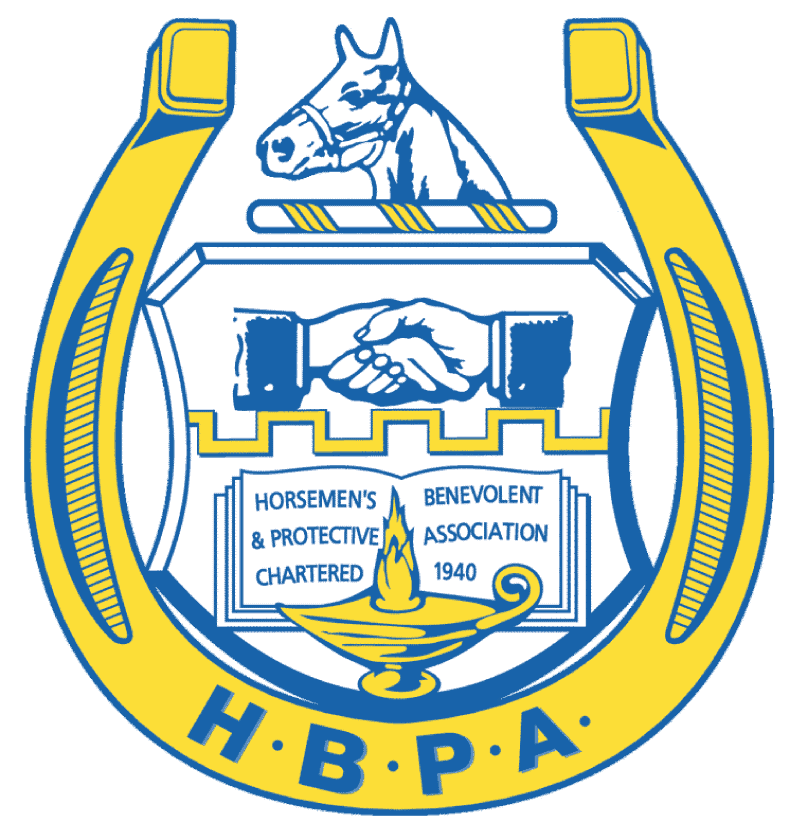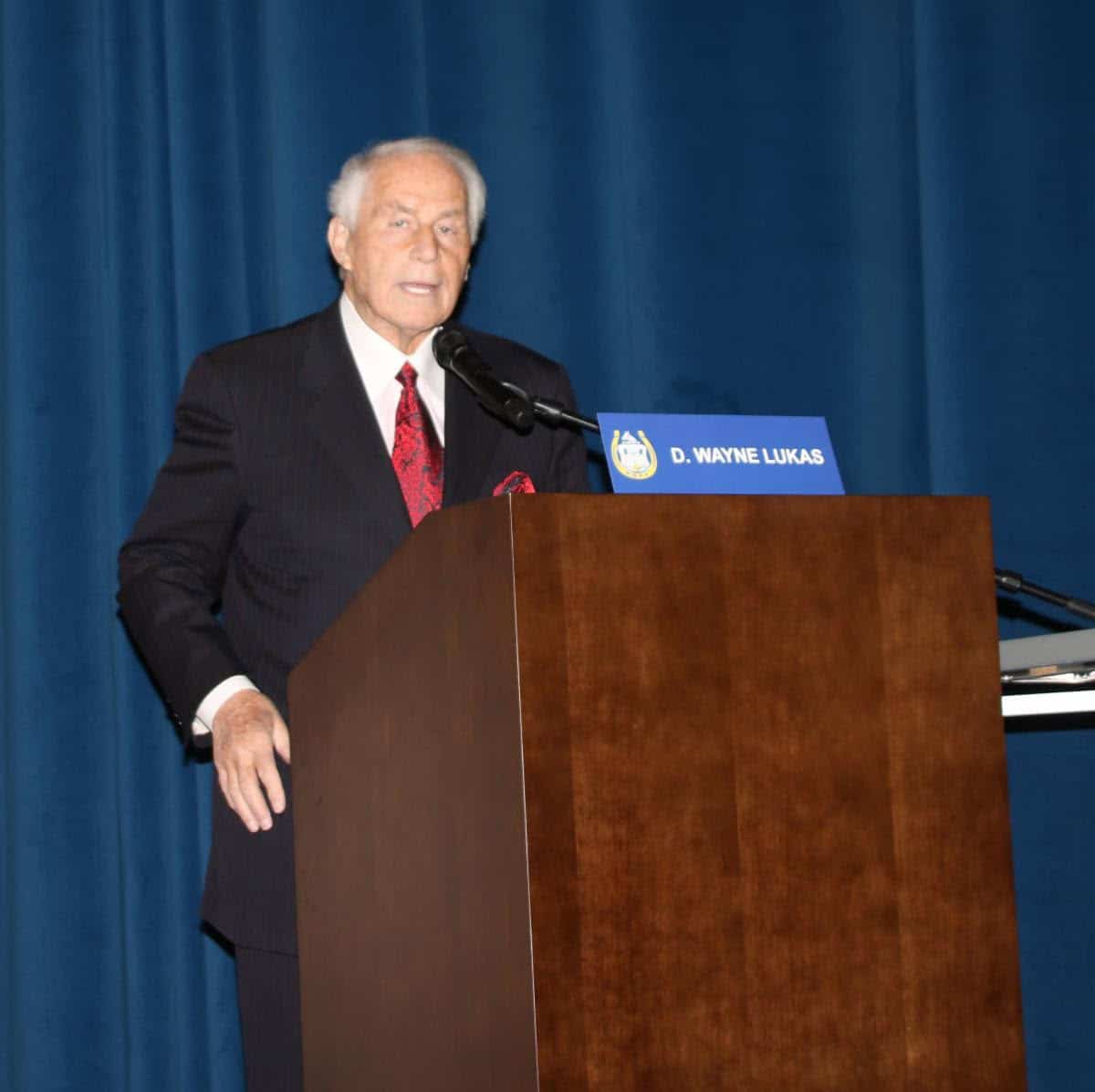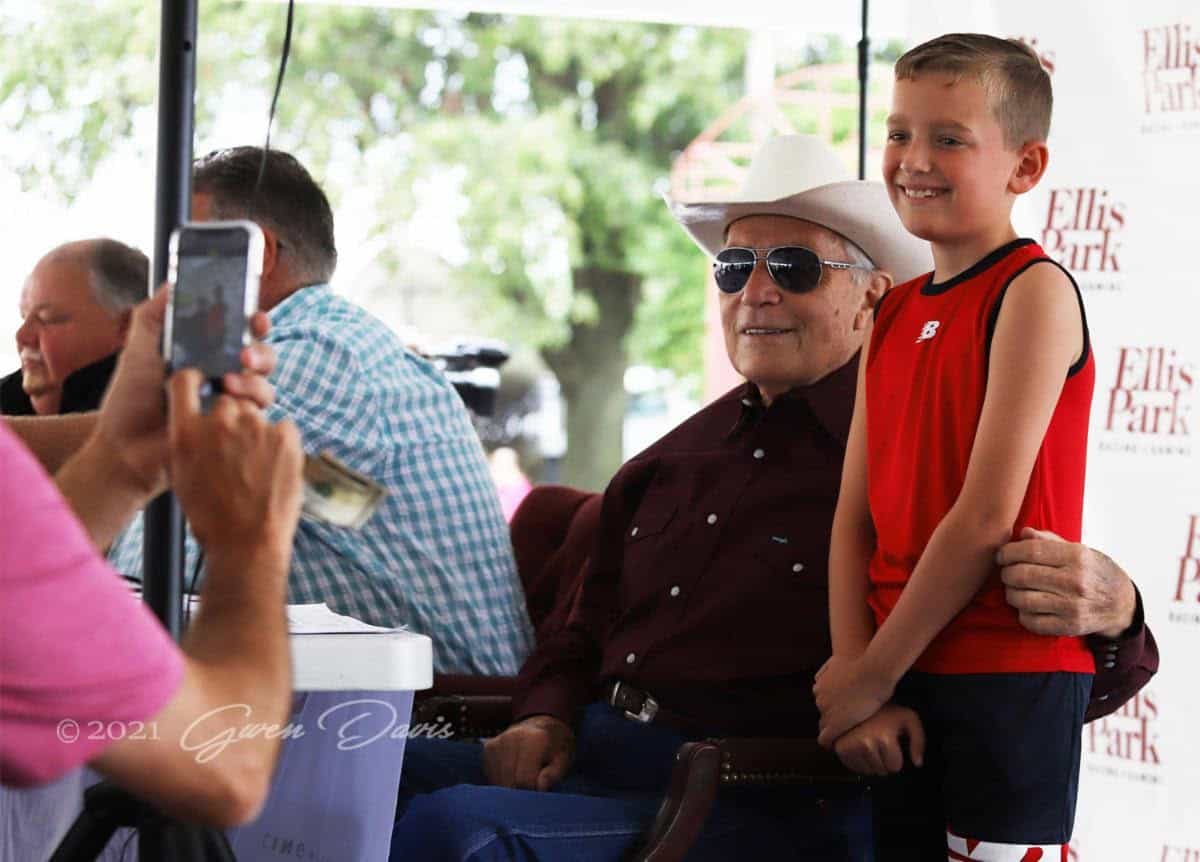Winter Warriors Stand Their Ground in KY
Blood-Horse
Trainer Jeff Greenhill remembered one winter several years ago when he decided to move his stable to Florida to enjoy the sunshine and warmth at Tampa Bay Downs.
“For those purses at Tampa, those races are really tough,” he said. “I’ve told people, ‘I went to Tampa for the winter and all I got was this Tampa Bay Downs T-shirt.'”
It wasn’t the best meet financially for Greenhill, whose regular winter home is Turfway Park. Weather aside, the winter of 2014-15 hasn’t been bad at all for the Northern Kentucky horseman. From Jan. 1 through March 8, his stable had 36 starts with 11 wins, eight seconds, and four thirds for earnings of $145,232, all at Turfway.
Greenhill, who currently has an 18-horse stable at Turfway in Florence, also ranked in the top 10 nationally by win percentage among trainers with at least 30 starts through March 8.
He is one of a number of horsemen who opt to stay in Kentucky for four consecutive months of racing at Turfway. It hasn’t been easy, as the racing week has shrunk in recent years because competition for racehorses with other tracks and an overall industry decline in pari-mutuel wagering.
“This place is very important to me in a bit of a convoluted way,” Greenhill said. “All my help lives around here; we all have residences in the area. These guys are so important to me. They’re wonderful horse people, and I can trust them to do right by the horses. In the summer when we’re running for big money, I’m going to need them.
“And our owners love to come here and get in the winner’s circle. I’ve held the line on my day rate for five years because I love getting people involved in the game. Without this place I would either be a seven-month-a-year trainer or be headed to Oaklawn Park, where I’d probably be getting my ass handed to me.”
From April through November, Greenhill becomes a road warrior. His Ohio-bred horses race locally at Belterra Park, the former River Downs, but he also races at Indiana Grand Race Course, Churchill Downs, Mountaineer Casino, Racetrack & Resort, and Presque Isle Downs & Casino.
“In my third year of training on the Kentucky circuit I made about $500,000 in purses,” Greenhill said. “To make that kind of money now, I have to keep my truck and trailer hooked up. To make the purse money we make, it’s a grind up and down the road. I must have traveled 60,000 miles last year.”
One of the barn favorites is 10-year-old Shakeyogroovething, an Ohio-bred gelding who has been trained by Greenhill for most of his 82-race career. He’s a horse that symbolizes Turfway racing—he has been fighting the good fight for a long time and always seems to have an ace up his sleeve when he most needs it.
Greenhill became owner of Shakeyogroovething early in his career privately at a bargain price and figures the gelding has earned close to $300,000 in purse money since that time. “Shakey,” as he is called by Greenhill’s grooms, several of which are in their late 50s and early 60s, owns the track record for 2 1/4 miles at Presque Isle Downs after lowering it twice.
In three starts at Turfway since December, Shakeyogroovething, a 13-time winner by Dance Brightly, has won twice and finished third in $18,000 claiming races. Greenhill would like the gelding to be eligible again for lower-level starter allowance races, but at this point doesn’t want to risk losing him by racing him for a lower tag.
“He does what we call the ‘Shakey Shuffle’—he walks back and forth in his stall,” Greenhill said. “No wonder he wants to go two miles when he races. All we do with him is gallop him a lot. He’s still very good at his age; I don’t think we’ve ever injected a joint.”
Not far away in another barn is a mare who has several years on Shakeyogroovething and means as much to her owner and trainer, Jamie Grubbs. And she’s just as popular with racing fans in Kentucky and Ohio, some of whom can’t recall a time when they didn’t see her on the track or the number of times she helped them cash exactas and trifectas.
Grubbs claimed Missing Sefa, a 13-year-old daughter of Sefapiano, at Turfway in December 2004 for $15,000. Up to that point she had raced 10 times with one victory.
As of her most recent race, in which she finished third March 6, Missing Sefa had career earnings of $348,821 from an amazing 107 starts and 28 wins, 19 seconds, and 17 thirds. Grubbs, who adores the mare and tears up when talking about her, lets Missing Sefa call the shots.
“She’s a member of our family,” Grubbs said. “She still loves to train and she’s so much happier at the racetrack. She wants to be the first horse out on the track. When we missed five days of training one week in February because of the weather, we had to open the door of the barn so she could look out at the track.
“Not a day goes by when someone in the family is not with her. Horses like this are so hard to come by. But if she’s not competitive, she’s not going to run anymore. After this meet we’re all going to have to sit down and talk about what to do, because her starter allowance eligibility expires. We don’t want to lose her.”
Grubbs, who has a five-horse stable, also has made the most of her opportunities at the winter/spring meet at Turfway. Through March 8 she had four wins, three seconds, and four thirds from 14 starts. A native of the area, Grubbs relies on the four months of racing to keep her operation intact.
“My family is here, and we can’t afford to keep two households,” she said. “I can’t go to a place like Tampa. It’s financially not feasible.
“At least we have a good rapport with (general manager) Chip (Bach) and the racing office. They’re really accommodating here, which isn’t the case elsewhere. I called Chip one morning at 5:30 and told him the lights in the barn weren’t working and he said, ‘What do you need?’
“Even with all the bad weather this winter, we only missed two days of racing. It’s not as bleak as it used to be here.”
Turfway, though not alone in the national Thoroughbred racing landscape, has struggled as competition from tracks with gaming in the region have increased purses and lured away horses and horsemen.
It has, however, always managed to rise above the labels usually awarded other northern tracks that race in the winter, in part because of a core of Kentucky-based horsemen that opt to stay home year-round, such as Tom Drury and Charles LoPresti. Eric Reed usually supports the meet, and though Mike Maker races in multiple states, he always leaves a good-sized group of horses at Turfway and topped the local standings with 12 wins through March 8.
This winter, trainer Wesley Ward has a stable at Turfway. He has some top horses based there, in large part because he likes training them on the synthetic Polytrack surface.
There’s little doubt the synthetic surface, first used in September 2005, has played a major role in keeping Turfway alive because of the time of year in which it races. Cancellations have been few this winter despite several snowstorms and days and nights when temperatures were in the teens.
This year, at least, if the track was cleared of snow and the wind-chill factor wasn’t less than 10 degrees, the trainers led their horses to the paddock and the jockeys rode them, albeit under less-than-ideal conditions. Those efforts have paid off, as wagering on the product has increased substantially this winter.
From a safety standpoint, catastrophic racing injuries at Turfway are among the lowest in the country. In 2014, when horses made 3,764 starts, the racing fatality rate was 1.06 per 1,000 starts, or half the industry average of 2 per 1,000 starts. In 2012 the rate was 0.58 per 1,000 starts; since the Equine Injury Database was launched, the Turfway figure hasn’t been higher than 1.67 per 1,000 starts.
“Conventional wisdom says with racing at that time of the year and with that population of horses, they should be wrestling with equine injuries there,” said Dr. Mary Scollay, equine medical director for the Kentucky Horse Racing Commission. “It has been a perfect storm, but a good storm.
“The bottom line is, many trainers there benefit from their long-term view of management of the horse. There aren’t that many claims there, so they can expect they will be leading the same horse back that they led over. The trainer decision-making process is about protecting the horse. For a majority of them, if they lose a horse, they won’t get another one to put in that stall.”
Scollay said this January “wasn’t a particularly good month” in terms of injuries, but the overall occurrence of catastrophic injuries was still lower than the national average. “It compares favorably (so far this year) with many other racetracks,” she said.
There has been behind-the-scenes talk the last five years that Kentucky doesn’t need a year-round circuit. Owners, trainers, and breeders with stock that fits the December-through-March schedule vehemently object to any such plans.
Turfway racing secretary Tyler Picklesimer has managed the horse population quite well given the circumstances—fewer horses are stabled in the barn area when compared with five or 10 years ago—and the 2014-15 field size numbers reflect trends of recent years.
For 16 programs in December, which featured four-day racing weeks, Turfway averaged 10.14 starters per race. In January, with 14 programs three days a week, field size averaged 9.19 horses per race. In February, with 10 days of racing, field size average fell to 8.12.
December traditionally is strong because some stables haven’t shipped yet to Arkansas, Florida, and Louisiana. Also, Mountaineer didn’t race last December, and just reopened in March.
“This product has always been well-received in the simulcast (market), and it gets good support from the local community,” Picklesimer said. “People may think there isn’t a need in Kentucky for a year-round circuit, but not everybody can play at Keeneland and Churchill Downs.
“There are the guys here that make the Cincinnati area home. They’re able to sleep in their own bed year-round and do their shipping in the summer months. They’ve supported us for years. There are a lot of horses (in the area); I think it’s more of an owner shortage than a horse shortage.
“The objective is to get people involved in the game, and then get them interested in owning or breeding. To bash a track like Turfway or Ellis Park does nobody in the industry any good.”
Picklesimer said the decision to race three programs a week in February rather than two like last year is a plus. Filling races isn’t any easier, but the extra day gives horsemen an incentive to stick around and perhaps attempt to add horses to their stables.
In an unexpected development, there have been two purse increases this winter, one $500 per race and the other $2,000 per race. The hikes have helped the locals that try to make ends meet during winter racing, but they haven’t increased field size.
Kentucky horsemen have said it wouldn’t take that much money—another $3 million a year for purses—to get trainers that usually head south for the winter to leave some horses behind at Turfway, as they used to do.
“That would change what we do here,” Picklesimer said. “Some of these lifetime conditions could be eliminated, and we could get some of the guys to upgrade.”
Greenhill said even $3,000 per race would make a big difference. He also suggested using any overage in the Kentucky Thoroughbred Development Fund to support claiming purses since the majority of races at Turfway are for claimers.
“I just subsist here because of the purse level, but it does allow me to exist,” Greenhill said. “I appreciate the fact Turfway allows me to hold onto my help and defray some costs. I never had the ambition to be a nomad.”
As Turfway prepares for the biggest day of its meet, March 21, which features a pair of grade III stakes—the $550,000 Horseshoe Casino Cincinnati Spiral Stakes for 3-year-olds and $150,000 Bourbonette Oaks for 3-year-old fillies—business has been surprisingly strong.
On the heels of a December Holiday meet during which total pari-mutuel handle on live racing increased 21.4% from the previous December, January and February were even stronger.
According to KHRC statistics, the 14 programs in January generated total handle of $25.6 million, up 48.4% from $20.1 million for 12 race cards in January 2014. In February, handle totaled $16.5 million for 10 programs, up 50.75% from $12.9 million for eight programs the previous year.
Bach, the Turfway general manager, cited a few reasons for the increase though he admitted it was unexpected.
“Obviously we were up against the polar vortex last year, but based on our forecast of revenue we’ve done better than we thought we would,” he said. “The meet has exceeded expectations, but field size was a major contributor. The goal is to keep seeking the sweet spot and take advantage of the right days, and maximize handle.”
Turfway in December switched from afternoon to evening racing on Saturdays, and the KHRC numbers reflect strong gains in handle on Saturdays. Bach said he believed avoiding major racing signals in the afternoon would help export wagering.
“Year-over-year the numbers have been good but we have a long way to go yet. We’ve been challenged by the ownership to maximize the winter months. We have to balance everything against the purse account so we’re not significantly overpaid by the end of the meet.”
Turfway has been owned by Rock Ohio Gaming (90%), which includes the heavily-in-debt Caesars Entertainment, and Keeneland (10%). Caesars, however, recently announced its intention to sell its share to Rock Ohio Gaming.
If Turfway is to increase purses outside of continued growth in wagering, it will have to come from historical race wagering, also known as Instant Racing. The track owners are waiting for a final court ruling on the machines—they resemble video lottery terminals but are considered pari-mutuel under KHRC regulations—before installing them.
“We’ve done the analysis on it and have worked on a footprint (for the facility),” Bach said of historical race wagering. “I think here’s a benefit to us in having it, but we can’t project a year from now what this market will look like. I think we have an advantage to do something in our market. We’d like it to compliment Horseshoe Casino Cincinnati.”
For 47 racing programs last year, Turfway paid $5.8 million in purses. Therefore, it’s not hard to believe another $3 million in the purse pool would have a major impact on the racing operation. Though the amount of revenue historical race wagering could generate—it has varied greatly between Kentucky Downs and Ellis Park—is hard to estimate, it probably would positively impact the racetrack.
One thing that hasn’t panned out in an otherwise good year so far for Turfway is the plan to keep the barn area open for stabling and training in the spring, summer, and early fall. Bach said the track would need about 400 horses to make it cost-effective, but applications were submitted for a little more than 100 horses, many of which are trained by horsemen who prefer to train at Turfway and ship to Belterra Park, Churchill, and Indiana Grand.
Beginning in 2013 Turfway reluctantly surrendered its September meet to Churchill at the urging of the KHRC and in turn gave up the one month of the year it could regularly schedule outdoor activities on the apron and near the paddock. Also lost was the Kentucky Cup Day of Champions, which vanished with no outcry from the Kentucky racing community.
What was left was four months of racing that relies heavily on weather conditions. But those four months account for one-third of the Kentucky racing calendar.
Bach remains optimistic—”I value winter racing because I love my job,” he said—that the racing and entertainment product at Turfway will continue to grow, albeit slowly. He acknowledged that’s better than heading in the other direction.
“We need positives to happen and then build off of them,” Bach said. “People come back here (to race and wager) because they love it and have a passion for it. We have good support.”





